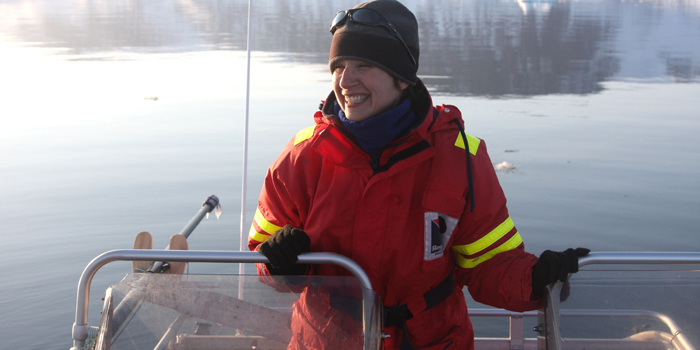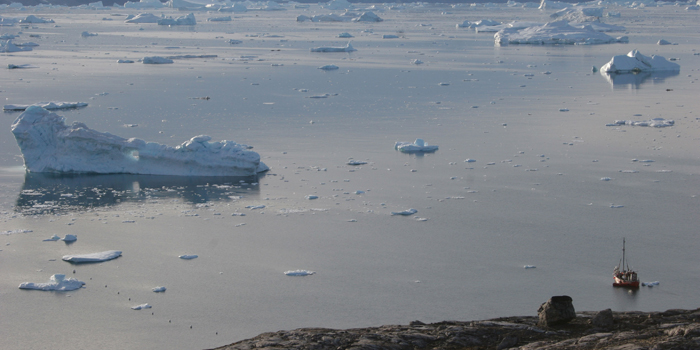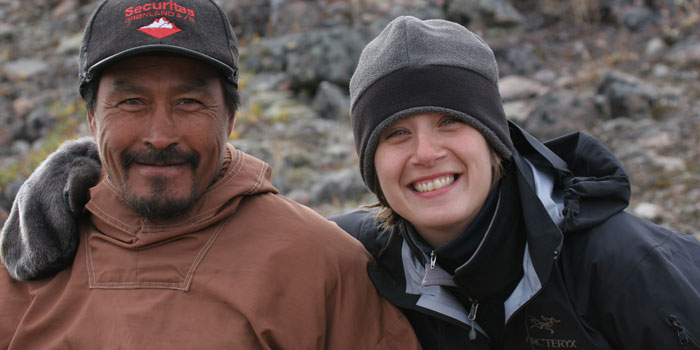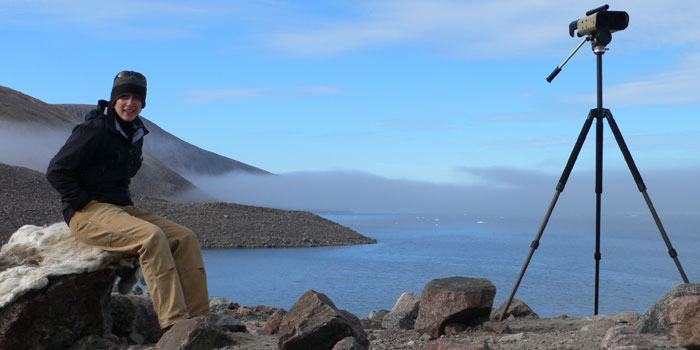Dr. Kristine Laidre: Video Transcript
Hear Kristine talk about her job and what it's like to conduct science while at sea. Download (mp4, 235 MB).
Introduction
My name is Kristin Laidre I'm an oceanographer, I work at the Polar Science Center in the Applied Physics Laboratory at the University of Washington. My job as a marine mammal biologist essentially involves being in the field, collecting information on marine mammals and then coming back to the office and analyzing that information, doing statistics, writing papers, making presentations. So its divided into two parts; being away from my office or being present at my desk.
In the field we have many different projects, sometimes we are focused on counting either from planes or boats, catching them and putting instruments on them or taking samples from animals that are live or have been harvested. So if I am tagging animals my responsibilities include looking out for them to see when they're swimming by, running boats, pulling them out of nets, and attaching instruments.
We put instruments on these whales in August and the animals make a very long migration south with the forming ice in the Arctic. They'll move out to a place called Baffin Bay in Davis Strait. So our plan in next March to fly out and helicopter several times from the coast, land on the ice where these animals are over-wintering both instrument more animals from the ice edge as well as collect oceanographic data like CTD from the cracks in the ice which can be used to calibrate the instruments that are on the whales right now.

Dr. Laidre talks about tracking narwhals during NOAA's Ocean Explorer Greenland 2006 Expedition.
Studying the Narwhal
So our NOAA Ocean Exploration project is basically two parts, its focused on instrumenting narwhals with satellite transmitters while they are in their summering grounds in North Greenland. Satellite transmitters are small packages that we attach to the dorsal ridge of animals that allow us to track their movements and their behavior underwater for many months at a time. So the first part of the project was to sail up in a small boat to catch Narwhals in nets and put these instruments on them, the second part will be to go out to Baffin Bay which is the spot where these whales over-winter and instrument them and take oceanographic samples.
So catching a Narwhal is a bit of a strange job, there are two ways to do it. You can do it from a boat or from land. You tie a line from the bow of the boat and along a line at the surface—then we essentially watch that net for 24 hours a day and monitor it until some whales swim in. When the whales swim in we go out in inflatable boats, pull the animals up to the surface and then tag them. When we are working on a field site on land we essentially have the same operation however instead of attaching a line to the bow of the boat we attach it to a big rock or some type of anchor on land and set the net straight from shore.
So the instruments we put on Narwhals are called satellite link time-depth recorders. They work in the since that they collect information about what the animal does while it is swimming under that water. And when it comes to the surface they transmit that information to polar orbiting satellites. In addition when the animal's at the surface, the signal from the tag allows for the calculation of where that animal is in space—so a longitude and latitude. Which means for many months of the year we know exactly how that animal moves through its environment and what it is doing under the water. After we release the animal with these tags on it I go back to my office and I can monitor what that animal does on the Internet every single day, I can log into my account in Argos, I see where the animal is, how it has moved around when it was diving and what it was doing in the water column.

Narwhal studies: determine the affects of climate warming on their winter grounds and uses them as an oceanographic platform with which to collect data on their ocean habitat.
The Elusive Narwhal
I am a marine mammal biologist, which is focused on Arctic species. Narwhals are a very good example of an Arctic species, but I also study other animals that live in the Arctic, Bowhead Whales, Balucca Whales, different species of seals, seabirds and things like that. While this project is focused on Narwhals, in the future I may be studying other animals that live at high latitudes.
The Narwhal is a medium sized tooth-whale that lives only in the Arctic, they actually only exist around the Canadian Arctic and east and west Greenland. So their very restricted in their distribution. Not very much is known about Narwhals, they have not been well studied and that is simply because they are very difficult to study, they live in remote places, far from civilizations, they live in a habitat that is dark for half the year, covered in ice for half the year and not easy to access. So any information we can collect on the species is of interest to biologists or marine mammal scientists.
In this study we interested in studying both the effects of climate change on Narwhals, how will reduced ice, or higher temperatures in the Arctic effect them - as well as using the Narwhal as an oceanographic platform. Which means the instruments we place on these whales actually collect data about the ocean for us. So we essentially use them as our assistants, collecting data for us in ice-covered months when oceanographers can't get out there.
Narwhals are an interesting species because they are one of the deepest diving marine mammals. When Narwhals reach their wintering ground in Baffin Bay in Davis Strait they make dives of over eighteen hundred meters, which is greater than fifty-four hundred feet. They essentially start at the surface and dive for approximately 25 or 30 minutes down to the bottom of Baffin Bay where they feed on flatfish called Greenland Halibut. Studying these animal's diving behavior is very interesting for a biologist because not that many animals can sustain such intense pressures below the surface of the water and stay under the water for so long.
So the Narwhal is best known for its tusk. The tusk is basically a bit tooth that grows out of the left upper lip of the male whales. The tusk can be almost three meters long and is extremely heavy - it is a spiral tooth. There are many legends about the tusk of the Narwhal - it is essentially the origin of the myth of the Unicorn as European whalers that were in the Arctic would catch Narwhals and bring the tusk back to Europe and made up great stories about what kind of animals they were attached to. But in terms of the biology of the animal the tusk is really used for social structure, social system, its used in dominance hierarchies and sort of established the ranks of makes within the pods, within the populations.

Challenging conditions: Dr. Laidre shares the challenges of ocean research in the Arctic.
Challenges of Being in the Arctic
Out in the field in the high Arctic there are lots of things that you might have at home, that are not available to you. It can be in some since quite rough, You don't have access to a shower, or clean clothes, or sometimes a dry bed. Many of the foods you might like to eat are not available. Of course you are dealing with the weather so that can make things a little bit wild, but in the same breath living in a field camp or living in a boat in North Greenland is fantastic, you're out in the middle of nowhere, where you don't see people for days, weeks or even months. The nature and the wildlife that you see is not rivaled by any place south where people go to find their nature experience.
The primary challenge in the field would be the weather which in the Arctic is very unpredictable and very wild. We often have big storms and lots of wind and snow, rain and ice and everything you can think of. Other challenges include, especially when you are driving boats and using nets is too much sea ice, or big ice burgs coming by and blocking things or getting into the nets. Finally another challenge is just finding the animals and making sure they are near your site.

Greenland culture: Dr. Laidre interviews some of the local "assistants" and shares stories and culture from Greenland.
Working with the People of Greenland
Well there are two things I like most - I very much like the nature it is fantastic unexplored wild nature that not many people have seen. So I like being in a rural area and seeing beautiful sites. Another thing I like very much is working with the people of Greenland. It's a very interesting culture and the people are some of the nicest most skilled humans I have ever met.
Actually my job would not be possible without the people of Greenland. There are about 60,000 people that live in West Greenland and different towns along the coast. When I fly into a town and set up a field camp I very much like to hire as many of those people as I can because they're extremely skilled, extremely good scientists and biologists in their own right - and very fun to work with. We hire local people from the town and they come out and essentially work as our assistants, we have a good time and get a lot of really good work done.

Dr. Laidre offers advice for future marine biologists!
On a Personal Note
The most rewarding part of my work is that not only to I learn a lot about biology, ecology and interesting animals and nature, when you work in the Arctic your science has relevance to the people. People that live in the Arctic rely on these animals for subsistence so learning more about how large the populations are, how they move around has a broader relevance that just what scientists are interested in.
My advice for students interested in being marine biologists would be to get involved in research as soon as possible. There are lots of opportunities to volunteer in either field projects or the laboratory, and you get exposure to what it is like to be a marine biologist.
Return to profile